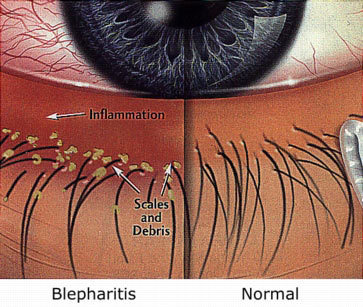At EyedeologyTM, we are now offering a new in-office treatment to eliminate Blepharitis. It will now be offered as a way of keeping those eyelids clean and healthy. It is a quick and easy procedure and most patients experience an almost immediate improvement in symptoms.

What is Blepharitis?
Blepharitis is a common eye condition where the eyelids become inflamed (swollen), with oily particles and bacteria coating the eyelid margin near the base of the eyelashes. This condition causes irritation, itchiness, redness, and stinging or burning of the eyes. There is no specific cause of blepharitis, but it can be associated with a bacterial eye infection, symptoms of dry eyes or certain types of skin conditions such as acne rosacea.
There are different types of blepharitis conditions that can affect the eyelids:
1. Anterior Blepharitis- affects the outside of the eyelid where the eyelashes are attached. This type of blepharitis is sometimes caused by a bacterial (or viral) infection. If this is not treated, then it can lead to inflamed inward or outward turned eyelids as well vision problems from in-turned eyelashes damaging the cornea.
2. Posterior Blepharitis- this results from blocked up oil glands (meibomian glands) on the base of the eyelashes. When the meibomian glands become clogged from posterior blepharitis, it can cause a stye or chalazion to form. This form of blepharitis also causes thickened eyelid margins and crusty eyelids. Both anterior and posterior blepharitis can occur at the same time.
3. Rosacea Blepharitis- this type of blepharitis is associated with ocular rosacea. Acne rosacea is a skin condition that makes the skin appear red with pimples on the surface. This type of blepharitis causes swelling and redness of the eyelids due to the oily glands not fully functioning.
What are the symptoms of Blepharitis?
The common symptoms are:
-crusting of the eyelids/eyelashes
-itchy or scratchy eyes
-redness/inflammation of the eyes
-dry eyes
-tearing
-eye and eyelid irritation
-eye rubbing
What causes Blepharitis to occur?
We all have bacteria on the surface of our skin, however in some people, bacteria accumulate in the skin at the base of the eyelashes. Large amounts of bacteria around the eyelashes can cause dandruff like scales and particles to form along the lashes and eyelid margins. Certain skin conditions such as seborrheic dermatitis (dandruff of the scalp and eyebrows), acne rosacea, allergic reactions to cosmetics or medications as well as eyelash mites (tiny organisms in the eyelash follicles) can cause blepharitis to occur.
How can I be examined for Blepharitis?
At EyedeologyTM, we do a full thorough eye examination on each patient. We will examine the eyelashes and eyelids on the slit lamp (microscope) and diagnose blepharitis based on our findings.
The newest treatment for blepharitis is an in-office procedure performed by our doctors at EyedeologyTM called BlephEx; BlephEx was developed by a board certified ophthalmologist. With BlephEx the doctor thoroughly and precisely eliminates the scruff and bacteria debris, the main cause of inflammatory lid disease. The traditional treatment was for the patient to scrub the eyelid margins with baby shampoo or commercially available lid care products. The BlephEx procedure is normally done in the clinic and only takes 5-10 minutes depending on the severity. BlephEx will reduce or alleviate chronic and debilitating symptoms. Treatments can be repeated every few months depending on the severity of the inflammation. Once the lids are clean, px’s can maintain and clean their lids at home. All patients are seen back at the clinic after 2 weeks to make sure they are happy with the treatment and evaluate their home lid scrub effectiveness. If demodex (eyelash mites) are suspected, then a second repeat treatment a week later should get rid of any hatchlings.
Research shows that almost 95% of patients will accept this procedure. The treatment is tolerated well; most patients experience a tickling sensation of the lids and lashes. Patients report an almost immediate relief from their symptoms. The overall health of the eyelid is improved by eliminating the inflammatory cause of blepharitis. Patients then start to produce more of their own tears and finally enjoy a life free from chronic and irritating symptoms associated with blepharitis and associated dry eye disease.
Learn more about BlephEx Click Here to see their Youtube Channel!

 587-353-5061
587-353-5061 Email Us
Email Us


 587-353-5061
587-353-5061